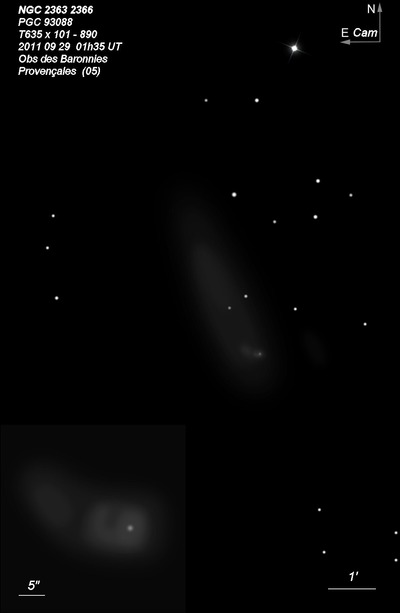
A 2010 study suggests NGC 2363 was very close to the southern tip of NGC 2366 less than 10 Myr ago, and could have triggered the interaction which has led to the strong episodes of star formation in the southern half of NGC 2366 as well as this galaxy.
Ralph Copeland discovered NGC 2363 on 9 Mar 1874 with the 72" while observing NGC 2366 = H III-748. He noted a "diffused nebulosity preceding, pos. 265.9°, dist 71.4"." Copeland's offsets were measured with respect to the unusually bright HII knot at the southwest end of the galaxy, which has always been assumed to be NGC 2363. But Copeland's "diffused nebulosity preceding" refers to UGC 3847, a separate galaxy ( or isolated star cloud) just west of the southwest end of NGC 2366.
CGCG misidentifies NGC 2363 as the "bright emission patch at the SW end of NGC 2366" and RNGC misclassifies NGC 2363 as nonexistent with the comment "Patch in NGC 2366, Zwicky". See Harold Corwin's identification notes for the complete story.
900/1200mm - 48" (4/15/10): NGC 2363 is either a small satellite galaxy of NGC 2366 or possibly a detached star cloud or galaxy west of the southwest end of NGC 2366. At 330x, NGC 2363 appeared fairly faint, moderately large, elongated 2:1 or 5:2 SW-NE, with a low but irregular surface brightness. Located ~2.2' SW of the center of NGC 2366 and 1.2' W of the bright knot. The bright HII knot/starburst region in NGC 2366 is often misidentified as NGC 2363.
Notes by Steve Gottlieb